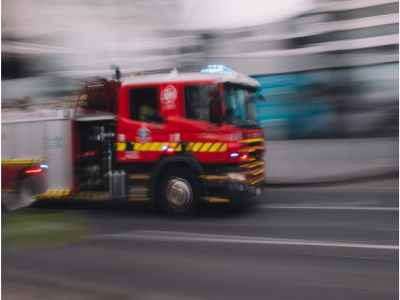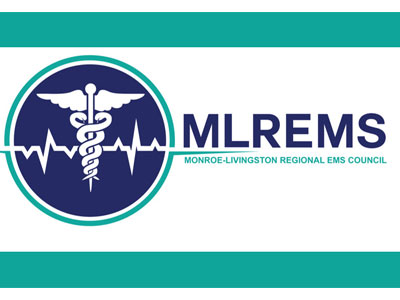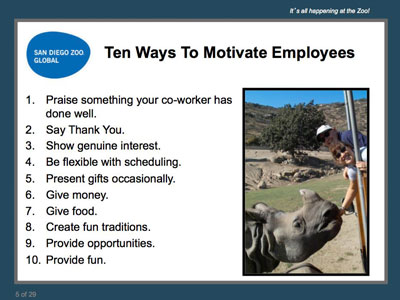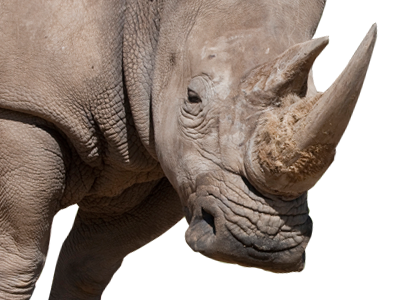 |
Sales Management: Forecasting Sales Revenue |
0.50 |
This course will focus on identifying sales forecast factors and types of sales forecasts as well as discussing various types of forecasting approaches. |
 |
Sales Management: Effective Sales Teams |
1.50 |
This course will focus on identifying the skills and daily tasks of a sales manager, interviewing sales professionals, identifying relationship-building processes, and identifying trust-building processes. |
 |
Sales Management: Effective Sales Performance |
1.50 |
This course will focus on training sales professionals, setting performance standards, evaluating performance, and conducting a sales meeting. |
 |
Safety Training for Supervisors |
0.75 |
This course covers the different challenges that supervisors face on the job site. You will also learn how to properly identify hazards within your work site and be able to investigate incidents where hazards harmed a worker. Finally, you will learn how to install safe practices in your team so that everyone is protected and the job runs safely. |
 |
Safety Communication and Training Techniques |
1.50 |
This course covers certain safety and logistics measures for the workplace. This includes topics like different types of safety training, creating safety programs with different learners in mind, and how to use various types of media to communicate objectives. |
 |
Safety and Survival in an Active Shooter Event in School Settings |
0.75 |
Welcome to Safety and Survival in an Active Shooter Event in School Settings. Recent national tragedies in schools remind us that the risk is real: an active shooter incident can happen in any place at any time in any school district. The best way to make sure you are safe is to prepare ahead of time and be ready.
Warning: Some of this content may be disturbing, if you need to take a break, please do so. If you exit and then come back into the course later, it will resume where you left off. |
 |
Safety and Survival in an Active Shooter Event (Corrections) |
1.00 |
Recent national tragedies remind us that the risk is real: an active shooter incident can happen in any place at any time. The best way to make sure you are safe is to prepare ahead of time and be ready. This course will take you through 3 different phases of an active shooter event: 1. Before: Prepare Ahead of Time; 2. During: Safety and Survival During an Active Shooter Event; and 3. After: Safety After an Active Shooter Event. |
 |
Safety and Survival in an Active Shooter Event |
1.00 |
An all too unfortunate reality is that active shooter events are occurring with alarming frequency throughout the world. This course is intended to make you aware of the steps you should take if you are ever involved in an active shooter event. |
 |
Safe Vehicle Operation |
0.50 |
This course covers the basic principles of safe vehicle operation, including an introduction to defensive driving concepts and tips for safe driving in rainy or snowy weather. |
 |
Safe Patient Handling |
0.50 |
This course is designed to provide healthcare professionals with the knowledge and skills necessary to safely handle patients in healthcare settings. The course will cover the principles of safe patient handling, equipment use, risk assessment, communication, and teamwork. |
 |
Safe Lifting Practices and Manual Material Handling (Corrections) |
0.75 |
This course covers methods for identifying risk factors related to lifting, carrying, and other manual material-handling tasks in the workplace. It includes how to plan and apply ergonomic improvements to reduce or eliminate those risk factors, thereby avoiding injuries, injury-related expenses, and loss of productivity. It also includes a selection of example ergonomic improvements that learners might choose to implement. |
 |
Safe Lifting Practices and Manual Material Handling |
0.75 |
This course covers methods for identifying risk factors related to lifting, carrying, and other manual material handling tasks in the workplace. It includes how to plan and apply ergonomic improvements to reduce or eliminate those risk factors, thereby avoiding injuries, injury-related expenses, and loss of productivity. It also includes a selection of example ergonomic improvements that learners might choose to implement. |
 |
Safe Infant Sleep: SIDS and the Safe Infant Sleep Position |
1.00 |
This course is focused on the American Academy of Pediatrics’ best practice recommendations for reducing the risk of Sudden Infant Death Syndrome (SIDS) and Sudden Unexpected Infant Death (SUID) and for promoting safe sleep in infant care settings.
Course Learning Objectives:
Define Sudden Infant Death Syndrome (SIDS) and Sudden Unexpected Infant Death (SUID), and their relationship to safe infant sleep in infant care settings.
Identify safe infant sleep position and safe sleep environments. |
 |
Safe Infant Sleep: Safe Sleep Policy |
1.00 |
This course is focused on safe infant sleep policies, and how to communicate best practice for safe sleep with the families of infants in your care.
Course Learning Objectives:
Explain the purpose and contents of a safe infant sleep policy.
Explore strategies for communicating with families about safe infant sleep practices. |
 |
Safe Infant Sleep in Early Childhood (CDA 1 and 4) |
2.00 |
This course is focused on the American Academy of Pediatrics’ best practice recommendations for reducing the risk of Sudden Infant Death Syndrome (SIDS) and Sudden Unexpected Infant Death (SUID) and for promoting safe sleep in infant care settings as well as safe infant sleep policies, and how to communicate best practice for safe sleep with the families of infants in your care. This course is also designed to be part of a Child Development Associate (CDA) Credential™ curriculum. It covers Subject Area 1: Planning a Safe, Healthy Environment to Invite Learning and Subject Area 4: Building Productive Relationships with Families. |
 |
Safe Handling and Restraint |
2.50 |
This course focuses on the planning process that is necessary prior to a procedure that involves the handling and restraint of any animal. Covering standard techniques for small mammals, birds, reptiles, and invertebrates that are most often encountered by animal care professionals in their first few years of employment, the goal for this course is to promote both human and animal safety during any routine handling and restraint procedure. |
 |
Safe Apparatus Response |
0.50 |
More than four thousand firefighters are injured each year in the United States while responding to and returning from emergency scenes. Response injuries account for roughly 7% of all fireground related injuries, however, they accounted for 29% of the line of duty deaths in 2020. This statistic exhibits the severity potential of unsafe apparatus response to and from emergencies. This course will identify hazards and risks associated with apparatus response and describe methods for reducing those risks. |
 |
RSI for the Non-RSI Provider |
0.50 |
This course is an overview of the RSI procedure and the means by which requests should be made for an RSI provider in the MLREMS system.
The course will describe the RSI process, indications for RSI in the prehospital setting, and what both ALS and BLS providers can do to assist in the RSI process.
Successful completion of the course and accompanying quiz will earn 0.5 hours of CME credit. |
 |
Robert's Rules of Order |
1.25 |
This course covers a general understanding of Robert's Rules of Order, the gold standard for facilitating discussions and group decision-making. Ideal for individuals involved in organizational leadership, community boards, and other decision-making groups, it is just one of many courses we offer. |
 |
Roaring Rewards: Creating a World Famous Employee Recognition Program |
1.00 |
Recognizing employees for hard work is an essential component to employee loyalty and a contributing factor to healthy workplace morale. Some employers go to great lengths to come up with recognition programs while others rely on the conventional method of simply praising employees for a job well done. There are a number of reasons you can choose to recognize employees and a number of ways to create an awards program. Take an inside look at how the world famous San Diego Zoo has truly established itself as an employer of choice with its innovative and robust "Roaring Rewards" employee recognition program. |
 |
ROAR: How to Build a Resilient Organization the World-Famous San Diego Zoo Way |
0.75 |
Roar: How to Build a Resilient Organization the World-Famous San Diego Zoo Way shows leaders at any level how to unleash the full potential of their teams to create lasting organizational resiliency rivaling that of the world-famous San Diego Zoo. It will show how the Zoo’s operating organization, San Diego Zoo Global, has utilized a set of innovative programs to create its team of exceptional leaders and engaged employees who have engendered its amazing accomplishments.
Featuring real-world stories, best practices, and specific strategies based on 100 years of exceptional leadership, this unique and valuable resource will help organizations of any size and focus to master winds of change, overcome stress and adversity, thrive in times of chaos, and constant in pursuit of their vision, and accomplish extraordinary things. |
 |
Risk Management Framework (RMF) DoD/IC Implementation 2022 |
24.00 |
Risk Management Framework (RMF) for DoD/IC Implementation 2022 focuses on the Risk Management Framework prescribed by NIST Standards and guided by DoD Instructions. This course is current as of May 2022. It was revised due to NIST producing new and updated publications over the preceding two years, including NIST Special Publication (SP) 800-37 R2; SP-800-53 R5; SP 800-53A R5; SP 800-53B; SP 800-160, versions 1 and 2; SP 800-171 R1 (among others); and various DoD updates to Instructions and guidance documentation. |
 |
Risk Management #1921 (Instructor Guide) |
1.00 |
This is the Instructor Guide for Lesson #1921 Risk Management. This instructor guide provides the instructor with lesson background, key points, delivery methods, and required materials. Included in this guide is an explanation video of the presentation that describes each slide of the lesson. This guide also details the class activity and provides instruction for presenting it as a conclusion to the lesson. |
 |
Rhinoceroses |
2.00 |
This course will provide an introduction to rhinoceroses, including an overview of physical characteristics, habitat, behavior, reproduction and the conservation efforts dedicated to protecting this taxonomic group. |
 |
Rhino Tissue Preservation |
0.50 |
Field Conservation Training: Using the supplies in a kit provided by the Institute for Conservation Research, in-country field workers will learn the step-by-step process for the collection, preparation and preservation of rhinoceros oocytes |


























